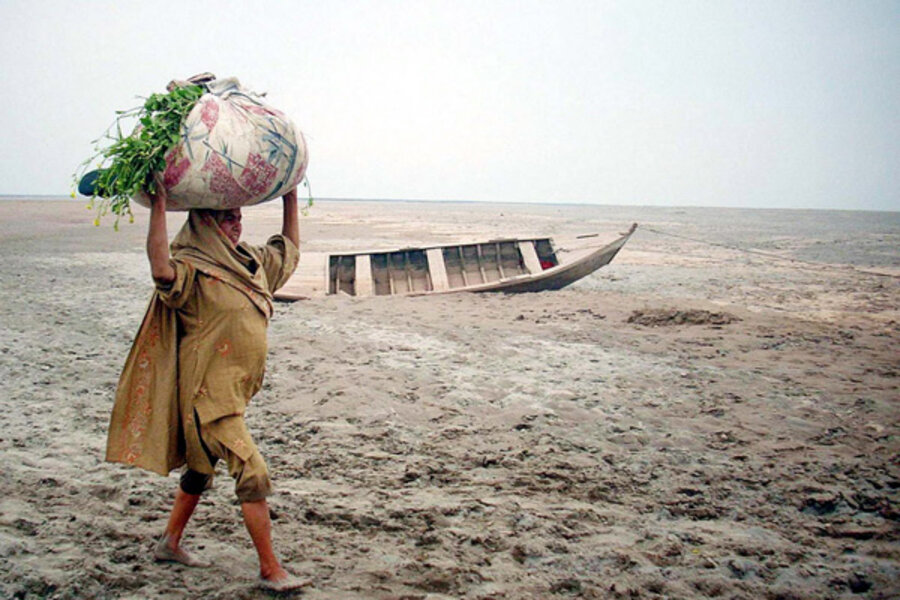The other Kashmir problem: India and Pakistan tussle over water
Loading...
| Srinigar, India
Amid a summer of heat, regional flooding, and separatist protests across Indian-controlled Kashmir, one of the unlikely grievances mentioned by rock-throwing youth is water.
India is building a series of hydroelectric dams in Jammu and Kashmir State, but much of the power they generate will be distributed to the wider Indian grid. For separatist-minded Kashmiris, this represents the theft of a birthright – and yet another reason to idealize independence.
"There will be a new project to create 4,000 megawatts to India, but still we don't have electricity," says Nadeem, a young independence activist who couldn't safely give his full name for fear of police reprisal. "Most journalists say, 'Oh, if you get independence, will you be able to survive?' We have the resources.... We have a lot of hydroelectricity."
As electricity becomes increasingly precious, water is also becoming a major impediment to resolving the Kashmir conflict, a dispute that hampers US efforts to coordinate regional cooperation in nearby Afghanistan.
More than 45 people have died in clashes between seperatist protesters and police since June. Even as New Delhi sends in more troops to impose a strict curfew, daily marches chant the slogan, "India, go back."
While a political solution looks far off, a near-term fix to the water dispute is being proposed by the state minister for irrigation, Taj Mohudin. He will put forward a new law this September that would charge water usage fees on the Indian hydroelectricity generators.
At present, India gives 12 percent of the power generated from dams in the state to residents free of charge, as a form of "royalty." Any extra power must be bought off the grid.
Water and Kashmir's independence
Mr. Mohudin's water usage fee would keep the free water coming, plus it would bring in about $215 million a year in revenue, he says. That makes independence – something he doesn't favor at the moment – more realistic in the future, he says.
"I feel that first we should be an economically viable state. And we have to find the ways and means to become economically viable," says Mohudin. Pointing to a binder with the proposed water usage fee legislation, he adds: "This will be my humble way of contributing."
Except, there's a number of problems. First, this wouldn't bring about economic independence since the state already pays far more for power off the grid: $537 million a year, according to Shakeel Qalander, president of the Federation Chamber of Industries Kashmir.
Furthermore, Kashmir state has tried taxing hydroelectric power in the past, which was struck down by the high court.
And finally, argues Ashok Jaitly, a water expert at The Energy and Resources Institute in Delhi, Kashmiris should not have a total right to the power and its proceeds when they are not financing the dams. If Kashmir financed the dams, he says, then 100 percent of the power would be theirs. But when the Indian government builds the dam, the 12 percent royalty is standard across India, Mr. Jaitly says.
Kashmiris are "too used to having it both ways financially. They don't want to pay for anything, whether it's water, or electricity, or roads, or anything," says Jaitly, who spent years working in Kashmir. "It may be a very crude way of putting it, [but they] have been using the political situation to extract monetary benefit out of the system, and then complain about it."
Mr. Qalander from the Chamber of Industries says the state has hydro potential of 20,000 megawatts (MW), which would give an annual revenue base of nearly $13 billion. But Jaitly puts the state's total hydroelectric potential at 18,000 MW, with at least 15,000 of that falling outside the Kashmir Valley in areas that are demographically less Muslim and less interested in independence.
Borders drawn by river flow
In that way, water could determine the borders of an independent state, with India and Pakistan fighting hard for control over the major rivers.
Much of Pakistan's irrigation flows from rivers coming out of Jammu and Kashmir. Pakistan has maintained an uneasy truce with India over the rivers through the Indus Waters Treaty of 1960. The Indus river system includes three western rivers – the Indus, the Jhelum, and the Chenab – and three eastern rivers – the Sutlej, the Beas, and the Ravi. For the most part, the treaty gives Pakistan control of the western waters, India the eastern.
New dam projects have put more strain on the treaty. India says they are all run-of-the-river, meaning no large volumes of water will be held back. But Pakistan worries about irrigating its farmlands.
The dispute is evident on a tributary of the Jhelum River, where India and Pakistan are racing to build competing dams less than 50 miles apart: India's is a 330 MW plant, while Pakistan's is 963 MW. Pakistan has hired Chinese crews in the hopes of finishing first.
Jaitly and Mohudin agree that the Indus Waters Treaty wouldn't apply to an independent Kashmir. That raises the prospect of Pakistan taking an aggressive stance on water rights.
"If there is an issue with Pakistan, it is only the waters, it is not with Kashmir. Pakistan has no other sympathy," says Mohudin.





